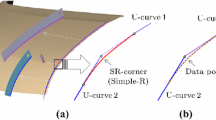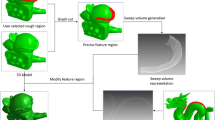Abstract
This study presents a new method for reconstructing an adaptive underlying surface, \(\tilde{\varvec{S}}\), from scanned data for styling design objects. \(\tilde{\varvec{S}}\) is usually generated by sweeping a curve that varies its shape gradually while being swept. However, when \(\tilde{\varvec{S}}\) is reconstructed from a segmented part of the scanned data, it is generally more difficult to control the gradual variation as the ratio of the segmented part to the area of \(\tilde{\varvec{S}}\) becomes smaller. Therefore, this study represents \(\tilde{\varvec{S}}\) by the sum of two surfaces, \(\tilde{\varvec{S}}={\varvec{S}}^{\mathrm{U}}+{\varvec{S}}^\Delta \). Here, an underlying surface \({\varvec{S}}^{\mathrm{U}}\) is generated by the standard sweep method and the difference surface \({\varvec{S}}^\Delta \) not only compensates for the error between \(\tilde{\varvec{S}}\) and the scanned data but also exhibits monotonous change in the curvatures. Consequently, the gradual change in a curve being swept is represented by \({\varvec{S}}^\Delta \), which does not encounter the aforementioned problem because it is intended to control the deviation from the “reference” \({\varvec{S}}^{\mathrm{U}}\) under the constraint of “curvature monotonicity.” The experimental results demonstrate the validity of surface reconstruction from real-world scanned data as well as an application of the proposed method.
















Similar content being viewed by others
References
Brent, R.P.: Algorithms for Minimization Without Derivatives. Prentice-Hall, Englewood Cliffs, New Jersey (1973)
Burchard, H., Ayers, J., Frey, W., Sapidis, N.: Approximation with aesthetic constraints. In: Sapidis, N.S. (ed.) Designing Fair Curves and Surfaces, pp. 3–28. SIAM, Philadelphia (1994)
Farin, G.: Class A Bézier curves. Computer Aided Geometric Design 23(7), 573–581 (2006). https://doi.org/10.1016/j.cagd.2006.03.004
Hildebrandt, K., Polthier, K., Wardetzky, M.: Smooth feature lines on surface meshes. In: Eurographics Symposium on Geometry Processing pp. 85–90 (2005)
Hosaka, M.: Modeling of Curves and Surfaces in CAD/CAM. Springer-Verlag, Berlin Heidelberg (1992)
Hoschek, J., Lasser, D.: Fundamentals of computer aided geometric design. A K Peters, Ltd (1993)
Inoue, J., Harada, T., Hagihara, T.: An algorithm for generating log-aesthetic curved surfaces and the development of a curved surfaces generation system using VR. In: International Association of Societies of Design Research, Seoul, Korea pp. 2513–2522 (2009)
Joshi, P., Séquin, C.: Energy minimizers for curvature-based surface functionals. Comput. Aided Des. Appl. 4(5), 607–617 (2007). https://doi.org/10.1080/16864360.2007.10738495
Mehlum, E., Tarrou, C.: Invariant smoothness measures for surfaces. Adv. Comput. Math. 8(1), 49–63 (1998). https://doi.org/10.1023/A:1018931910836
Meier, H., Nowacki, H.: Interpolating curves with gradual changes in curvature. Comput. Aided Geom. Des. 4, 297–305 (1987). https://doi.org/10.1016/0167-8396(87)90004-5
Moreton, H.P., Séquin, C.H.: Functional optimization for fair surface design. Comput. Gr. 26(2), 167–176 (1992). https://doi.org/10.1145/142920.134035
Nelder, J.A., Mead, R.: A simplex method for function minimization. Comput. J. 7(4), 308–313 (1965)
NLopt (Nonlinear optimization library, 2.4.2): (2014). http://ab-initio.mit.edu/wiki/index.php/NLopt
Piegl, L., Tiller, W.: The NURBS Book, 2nd edn. Springer, Berlin (1997)
Tsuchie, S.: Reconstruction of underlying curves with styling radius corners. Vis. Comput. 9(33), 1197–1210 (2017). https://doi.org/10.1007/s00371-016-1282-4
Tsuchie, S.: Reconstruction of underlying surfaces from scanned data using line of curvature. Comput. Gr. 68, 108–118 (2017). https://doi.org/10.1016/j.cag.2017.08.015
Tsuchie, S.: Reconstruction of intersecting surface models from scanned data for styling design. Eng. Comput. (2019). https://doi.org/10.1007/s00366-019-00817-x
Tsuchie, S., Okamoto, K.: High-quality quadratic curve fitting for scanned data of styling design. Comput. Aided Des. 71, 39–50 (2016). https://doi.org/10.1016/j.cad.2015.09.004
Várady, T.: Automatic procedures to create cad models from measured data. Comput. Aided Des. Appl. 5(5), 577–588 (2008). https://doi.org/10.3722/cadaps.2008.577-588
Weiss, V., Andor, L., Renner, G., Várady, T.: Advanced surface fitting techniques. Comput. Aided Geom. Des. 19(1), 19–42 (2002)
Westgaard, G., Nowacki, H.: Construction of fair surfaces over irregular meshes. In: Proceedings of the 6th ACM Symposium on Solid Modeling and Applications, pp. 88–98. (2001). https://doi.org/10.1145/376957.376969
Yamada, Y.: Clay Modeling: Techniques for Giving Three-Dimensional Form to Idea. Sanéishobo Publishing, Shinjuku-ku (1993)
Ziatdinov, R.: Family of superspirals with completely monotonic curvature given in terms of gauss hypergeometric function. Comput. Aided Geom. Des. 29(7), 510–518 (2012). https://doi.org/10.1016/j.cagd.2012.03.006
Funding
The author declares that this study was not funded from anywhere. (No funding was received).
Author information
Authors and Affiliations
Corresponding author
Ethics declarations
Conflict of Interest
The author declares that he has no conflict of interest.
Additional information
Publisher's Note
Springer Nature remains neutral with regard to jurisdictional claims in published maps and institutional affiliations.
Rights and permissions
About this article
Cite this article
Tsuchie, S. Reconstruction of adaptive swept surfaces from scanned data for styling design. Vis Comput 38, 493–507 (2022). https://doi.org/10.1007/s00371-020-02030-0
Accepted:
Published:
Issue Date:
DOI: https://doi.org/10.1007/s00371-020-02030-0




